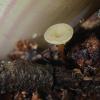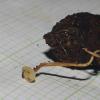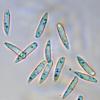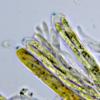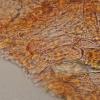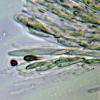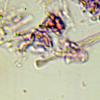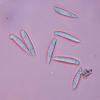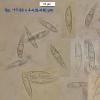
18-12-2025 21:17
Pol DebaenstThe identification took me to Byssonectria deformi

15-12-2025 07:09
 Danny Newman
Danny Newman
indet. Rutstroemiaceae sp. on unk. fallen leavesMc

19-12-2025 10:10
Patrice TANCHAUDBonjour, récolte réalisée en milieu dunaire, a

18-12-2025 17:23
 Bruno Coué
Bruno Coué
Bonjour,je serais heureux d'avoir votre avis sur c

18-12-2025 18:07
Margot en Geert VullingsThese plumes were found on rotten wood.They strong

17-12-2025 18:35
 Michel Hairaud
Michel Hairaud
Bonjour à tous/Hi to everyone I am passing along

15-12-2025 15:48
 Danny Newman
Danny Newman
Melanospora cf. lagenaria on old, rotting, fallen

15-12-2025 15:54
 Johan Boonefaes
Johan Boonefaes
Unknown anamorph found on the ground in coastal sa
Hymenoscyphus ?
Carmel Sammut,
07-05-2015 22:17
The specimen is solitary with a very long stipe. Asci IKI+ve - I think croziers +ve, Paraphyses cylindrical not inflated. Spores (16.3) 16.7 - 19.4 (22.3) x (2.8) 3.1 - 4.4 (4.7) µm with small oil drops - (some with a central septum?).
I'm not sure what it is any help would be apreciated.
Hans-Otto Baral,
07-05-2015 23:02

Re : Hymenoscyphus ?
Surely it is of the Hym. fructigenus group and maybe even that species. The ascus base I think is without croziers. In my area the species appears only from August onwards, but maybe on Malta this is different.
Carmel Sammut,
08-05-2015 18:50
Re : Hymenoscyphus ?
Thank you for your reply. The other collections of H. fructigenus were made in November and January and always on Q. ilex pods. Temperatures are too high in August and even at this time it is already dry and getting hotter finding less and less specimens every field trip!
Martin Bemmann,
08-05-2015 21:05

Re : Hymenoscyphus ?
Dear Carmel,
I suspect there are cilia at least at the acute ends of the spores. Could you check this?
There are several Hymenoscyphi of the "fructigenus" type, but on Quercus ilex (new to me) would be nice to know the spore type.
Regards
Martin
I suspect there are cilia at least at the acute ends of the spores. Could you check this?
There are several Hymenoscyphi of the "fructigenus" type, but on Quercus ilex (new to me) would be nice to know the spore type.
Regards
Martin
Carmel Sammut,
08-05-2015 22:14
Re : Hymenoscyphus ?
Unfortunately I cannot be much help as I do not have an oil immersion lens. I had the impression that there were some cilia on some spores at the acute end but it was not clear on the spores of this specimen and on another collection that I have which I considered as the typical H. fructigenus. I am attaching another photo taken from the same specimen.
I have the dried material if you wish I can post it. This collection was a single specimen and there is only a bit of material available. If you want I can send the other collection as well.
I have the dried material if you wish I can post it. This collection was a single specimen and there is only a bit of material available. If you want I can send the other collection as well.
Hans-Otto Baral,
08-05-2015 23:41
Martin Bemmann,
08-05-2015 23:53

Re : Hymenoscyphus ?
Thank you Carmel and Zotto,
I am now even more convinced that there are setae such as reported in Bernard Declerqc's provisional key also from seed cupules of Quercus robur.
Best regards
Martin
I am now even more convinced that there are setae such as reported in Bernard Declerqc's provisional key also from seed cupules of Quercus robur.
Best regards
Martin

